Shinobido: Way of the Ninja
| Shinobido: Way of the Ninja | |
|---|---|
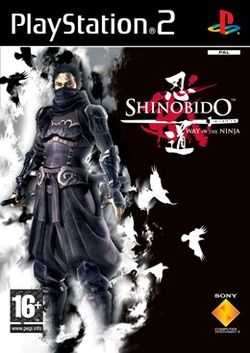 | |
| Developer(s) | Acquire |
| Publisher(s) | |
| Platform(s) | PlayStation 2 |
| Release date(s) | |
| Genre(s) | Stealth action |
| Mode(s) | Single player |
Shinobido: Way of the Ninja (忍道 戒 Shinobidō: Imashime) is a stealth video game developed by Acquire and released for the PlayStation 2 in 2005.
Plot
Prologue
End of the Muromachi period – the late 16th century: The power of the Ashikaga government is on the decline after the Ōnin/Bunmei civil war. Civil unrest is on the rise and conflict rocks province after province. Even Utakata, long peacefully ruled by the House of Ichijō, is now threatened. It was thought that the combined protection of the House of Ichijō and the Asuka Ninja would preserve the peace in Utakata. But this time of peace came to an end when the Asuka Ninja clan was destroyed in a single night... The provincial lords, who had been watching and waiting for an opportunity to strike at Utakata, wasted no time in making their moves. And they were accompanied by rival ninja clans hoping to take the place of the Asuka Ninja. Besieged by rival governments and ninja clans, Utakata stands on the brink of war.
Story
Shinobido has the player take the role of an amnesiac ninja who wakes to find himself lying on the bank of an unfamiliar river. In fact, everything is unfamiliar, as the man finds that he can no longer remember his identity and has no memory of his life or situation up until the point of his regaining consciousness. Finding only a sword lying next to him on the ground, the man stumbles across an isolated and seemingly derelict shack, only to have an arrow shoot past his head and lodge itself into the shack's outer wall. Startled, the man scans the trees and undergrowth surrounding him, but then notices a letter attached to the arrow. The letter states that the person who wrote it is simply a "concerned bystander," and further identifies the amnesiac man as "Goh," a ninja of the Asuka clan, which was wiped out the previous day. The letter informs Goh that his memories and soul have somehow been stolen and placed within eight mystical stones which were scattered during the initial attack on the Asuka ninjas' village, and then further scattered by people who have located and claimed the stones.
Using the run-down hut as a base-of-operations, Goh must locate the stones to reclaim his memory and discover the truth regarding the destruction of the Asuka ninja. However, this monumental task would prove impossible without the assistance of powerful and knowledgeable allies, and Goh is advised by the mysterious writer of the letter to gain the trust and protection of one of three powerful warlords and charismatic leaders within his proximity. Goh is further advised to begin his search in Utakata Castle, where the kind and noble Nobutero Ichijo resides. Ichijo and the Asuka ninja apparently together maintained peace throughout Utakata. With the destruction of the latter, Utakata now appears on the brink of war as ambitious neighbouring warlords and religious leaders turn their attention towards the vulnerable province. Goh must decide whether he will trust Ichijo, or instead ally himself with one of the other leaders vying for control of the region.
Gameplay
Missions
The player takes control of the Asuka ninja, as Goh, "The Crow," who conducts various missions and tasks, primarily stealth-based, for one of three warlords competing for Goh's allegiance. Missions include assassination, escort duty, protection, theft, kidnap, and various other clandestine operations at the request of the lords, and are delivered by a mysterious individual who shoots a message-carrying arrow into the wall of Goh's shack, the usual method of notification, used throughout the game. Generally, several missions will be available to the player at any given time, and will sometimes involve locating and claiming one of the eight stones containing Goh's memories and soul, after gaining the trust of a particular lord, who will then advise you of the stone's whereabouts. The character is also guided by the mysterious "Onji", who helps him in his search for the truth, for his memories and for the greater evil that threatens Utakata.
Abilities
As a ninja, Goh is swift, agile, and silent, and can use these attributes to his benefit during missions. Although Goh is a capable combatant, he will generally be at a disadvantage in a straight sword fight, as his opponents are larger in number and are often more skillfully trained in direct kenjutsu than he is. Goh will encounter heavily-armoured rival ninja, extremely skilled yojimbo, ronin warriors, and large groups of an opposing lord's regular guardsmen, who will often call for reinforcements or sound the alert if they become aware of Goh's presence. It is very much in Goh's favour to utilise stealth tactics to avoid detection, such as crouching behind ledges and walls, climbing across rooftops, and sneaking through canals. Such tactics will allow Goh to accomplish his tasks with minimal interference, or until the enemy can be picked off slowly and silently, one-by-one.
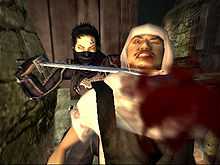
Stealth attacks
Goh is capable of using the landscape to his advantage. By running along walls, leaping the space between rooftops, or by being hidden behind obstacles or by rainy weather, Goh can perform a "stealth kill" on an unsuspecting opponent. If Goh is spotted or heard, the enemy may deflect or prevent the attack. For example, if an opponent catches sight of Goh just as he creeps up from behind to slit his throat, he may grab Goh's arm and struggle for his life, with Goh still able to make the kill under the right conditions, depending on the opponent's strength and alertness. There are many types of stealth kills available to the player, and some cannot be prevented by the enemy. Using railings, pools of water, or when enemies are distracted into examining items left lying around will present Goh with the greatest opportunities for a stealth kill. Goh can then carry fallen enemies or allies into shadowy corners, or drop them down wells or into rivers, to prevent the enemy from finding the bodies and sounding a general alert.
Onscreen indicators
Just as the Tenchu series did before it, Shinobido uses a type of "Ki Meter." However, where Tenchu uses a number-based system to judge the distance and awareness of an opponent, Shinobido uses a colour-based system to judge the enemy's status. When approaching an opponent or group of opponents, a pair of eyes will appear at the top of the screen, with an individual set of eyes for each enemy within Goh's range. If the eyes are grey, the enemy is unaware of Goh's presence. Purple eyes indicate that the guard has become alert or cautious due to a noise or having seen something in the distance. Red will indicate that the opponent has identified Goh or one of Goh's allies and is closing to attack. Orange indicates that the enemy has lost sight of Goh, but is still attempting to locate him. The shape of the border around the eyes indicates an individual's status, with different shaped borders for enemies, changed to show danger presented, and allies.
Strategy and tactics
The open-ended nature of Shinobido allows the player to continue the game for as long as he/she wishes to do so. The game can only advance and finish as the player selects specific missions. If the player continues to select alternative missions rather than those necessary to advance through gameplay, the war can effectively be sustained indefinitely or until the player decides to eliminate two of the warring factions and locate all of the mystic stones. Due to this style of gameplay, missions take place in pivotal strategic locations throughout Utakata rather than on uniquely specific levels. These locations include commercial hubs such as Sengen Town and Ryonin Market, transport routes such as Dandala Peak and Rokudo Valley, and the strongholds of each individual warlord, such as Fudo Castle and Sotai Tower. One mission may have Goh attempting to sabotage a transport cart full of food or weapons bound for the front by attacking the convoy in Rokudo Valley, whilst the next mission may have Goh returning to the same location to exterminate a group of barbarians who are attacking allied convoy shipments.
There are pseudo-realtime ramifications to various tactics. For example, if there is no rice (if the player stole it or destroyed the cart transporting it) for a particular warlord, his/her soldiers will be less focused, weaker, and much less dangerous, repeatedly complaining about their severe hunger and alerting Goh to their positions. If the player opts not to eliminate a rampaging bear in the mountain or forest regions surrounding Utakata in one mission, the beast will likely find its way into the town settlements, leaving the player the responsibility of rectifying the resulting chaos at a later point in gameplay.
Interactions with the feudal lords are important. The player may be required to carry out a mission in one lord's castle, at the behest of another lord, although this mission will not involve contact or interaction with said opposing lord in any way. They are simply there. One lord will write haikus, another will conduct prayer ceremonies, etc. Due to this fact, the player may decide not to comply with the objectives of a given contract, and instead choose act for his/her own ends. One example would be accepting a contract to steal food, money, or documents from the castle of one lord and transporting them to the lord contracting Goh's services. Instead, the player may assassinate the lord occupying the castle. Stealing provisions, assassinating enemies and allies alike in secret, and gaining a lord's complete trust so as to eliminate him later is all quite possible. However, such actions require prudent planning and a certain level of skill on the player's part. Nevertheless, the previously set objectives can fail or succeed, with Goh's trust with the contracting lord increasing or decreasing depending on the player's choices. The player's imagination and ability are what govern the ability to drive a faction toward famine and ruin, or toward power and prosperity.
Witnesses can also be problematic for Goh. Should Goh choose to accept a contract from one lord against another for whom Goh has worked on other occasions, the second lord will feel personally betrayed and likely request his/her troops hunt down and execute Goh. This can become especially tedious if said lord consistently contracts rival ninja or barbarians to attack Goh's hideout. Failure to fend off these attackers will result in Goh's hard-earned money and items being stolen by the enemy, although successfully remaining hidden and earning an "Invisible" rank at the end of each mission will prevent this from occurring to some extent.
Characters
Main characters
Goh encounters other ninja throughout gameplay. Some are friendly, while others are hostile. Some make their intentions known, while others appear from nowhere, launch into attack, and then vanish just as quickly. The most prominent characters are:
- Goh "The Crow" (鴉のゴウ Karasu no Gō) – The main character and protagonist of Shinobido, Goh appears to be widely known throughout Utakata, and has apparently gained many enemies throughout his previous life. Goh's only remaining purpose is to find the eight mystic stones containing his soul and memories and to uncover the truth behind the destruction of the Asuka ninja (飛鳥忍者). However, as each day passes, Goh will discover that perhaps the truth is best left unknown.

- Kinu "The Canary" (金糸雀のキヌ Kanariya no Kinu) – A mysterious, young kunoichi whom Goh will encounter during his missions. She is clad in red clothing, and has a cloud-shaped tattoo—similar to the design featured on the Asuka's clothing—on her thigh. She does not appear openly hostile towards Goh, but what are her intentions and can she be trusted? Kinu may or may not be a surviving member of the Asuka ninja, although if so, how and why did she survive the attack?
- Zaji "The Hawk" (黒鷹のザジ Kurotaka no Zaji) – A one-eyed ninja who wears an Asuka-style uniform, fighting with the same sword and in Asuka-style martial arts. Although Zaji does not speak, he appears extremely hostile toward Goh and each encounter with him will involve open combat. What are his reasons for wanting Goh dead? Was he somehow involved in the destruction of Asuka Village?
- Hebitonbo and Uzumushi (蛇蜻蛉&渦虫) – Two rival ninja who arrive in Utakata to reap the rewards of war. The pair are intent on hoarding contracts and establishing a name for the mercenary clan that they command; the Kenobi ninja. While both are powerful and difficult to overcome in direct confrontation, they are dimwitted and short-tempered, leading them to a great many failures by their own mistakes.
- Ageha and Usuba (揚羽&薄羽) – Twin sisters and leaders of the Mosu ninja clan, which has become involved in the conflict in Utakata. Whilst using the war to fund their operations, the sisters' true purpose for entering Utakata is to hunt down and kill Goh. Ageha and Usuba were once triplets. However, according to the pair, their sister Tateha was mercilessly executed by Goh during a battle between the Asuka and the Mosu clans. Goh does not recall this event, although the twins care very little for this fact and will attempt to kill Goh once they have successfully pinpointed his location.
- Kabuto (冑) – Leader of the heavily-armoured Taraba ninja. Kabuto utilises cannons and a heavy-hitting zanbatō-styled sword to pulverise his opponents. Although the Taraba arrive in Utakata as the war begins, seeking profit just as the Mosu and Kenobi do, Kabuto appears more intent on retrieving the mystic stones than accepting the highly paying battle contracts. Why does Kabuto want the stones and what purpose would it serve him to possess them?
The warring clans
- The House of Ichijo (一条家 Ichijō-ke) – The House of Ichijo, alongside the Asuka ninja, has maintained peace and order throughout Utakata for generations. Although the Asuka did not directly serve the Ichijo Family, the two parties had a long-held alliance designed to benefit and safeguard the people of the region. Currently under the rule of the virtuous and peaceful Nobutero Ichijo (一条信輝, Ichijō Nobutero, in Japanese naming order), many neighbouring leaders and powerful social figures have long despised Ichijo as a weak and cowardly ruler. Now, without the presence of the Asuka ninja, these leaders have decided to claim Utakata for themselves. Ichijo despises war and cares deeply for his people, going to great lengths to ensure the safety of Utakata's people, using financial and military resources to eliminate the barbarian tribes and wild animals infesting the province. According to Onji (オンジ), Goh and Ichijo were once very close, almost as father and son, and Ichijo intends to continue this relationship, although Goh's allegiance may now lie elsewhere.
- The House of Akame (赤目家 Akame-ke) – Kagetora Akame (赤目影虎 Akame Kagetora) is a former samurai and ruler of Fudo Province, which borders Utakata. Kagetora has gained a fearsome reputation for his short temper and violent nature, and is known to swiftly execute those who fail or betray him. Having amassed vast wealth through dealings with China, the Akame Clan is the richest, largest, and most well-equipped faction of the three. Believing Utakata to be the first step towards conquering all of Japan, Akame has wasted no time in mobilising his armies for a military offensive against the House of Ichijo. Akame has become familiar with Goh's reputation as an efficient assassin, who reminds him of himself as a young man. Upon hearing of Goh surviving the extermination of the Asuka ninja, he is highly impressed. Although distrustful of Goh, Akame recognises the advantage an Asuka ninja would afford him during the invasion of Utakata and attempts to recruit Goh's services, offering vast wealth and power beyond imagination should he choose to accept.
- The Amurita Faith (阿無璃他教 Amuritakyō) – Led by their charismatic leader known only as Lady Sadame (貞女 Sadame), the Amurita Faith have gained widespread support amongst the peasant and merchant classes who fund the divine Amurita's coffers with financial and material donations. Lady Sadame was born the daughter of a farmer, which is why the peasants of Utakata have become smitten with her teachings and rhetoric, offering resources, and their services en masse, to support the Amurita Faith. Lady Sadame regularly demands such funding and offerings from her faithful followers, to support her sizable military and to pay for her lavish clothing and luxurious lifestyle. Those followers who choose to stray from the divine Amurita's teachings or opt to hold back on donations are swiftly and sternly punished. Although neither Ichijo nor Akame truly consider Sadame a threat to their positions, both attempted to gain her allegiance before the outbreak of the war, which she strongly refrained from giving. Lady Sadame is well aware of Goh's reputation, and has long been envious of the protection afforded to Ichijo by Goh and the Asuka ninja, believing Ichijo to be weak and unworthy of the ninjas' services. She asks that Goh serve her in the same manner, so that she may prove to him that she is a leader worthy of his trust.
Opponents
Goh will face a large number of opponents as he hunts for the mystic stones. Especially deadly are the rival ninja factions and individuals listed below.
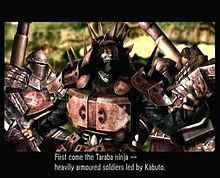
- Taraba ninja (多羅場忍軍 Taraba-ningun) – The Taraba ninja rely on brute strength and hard-hitting weaponry. Covered in armoured suits and wielding shoulder-mounted, light cannons and underslung blades fixed to their forearms, the Taraba move exceptionally slowly and make a lot of noise as they do so, even when simply turning to look in a particular direction. This makes Taraba ninja easy to locate and monitor during the course of a mission. The difficulty when confronting a Taraba ninja lies in direct conflict. Due to their heavy armour, they are well-defended and can withstand most of Goh's assaults. A Taraba ninja will not even flinch when taking damage unless Goh is using his strongest offensive techniques. Fleeing from the Taraba proves difficult also, as their cannons can cause severe damage from a great distance. If encountering multiple Taraba ninja in direct conflict, Goh's best chance for survival lies in escape. Taraba ninja will sometimes be seen working alongside their leader, Kabuto.
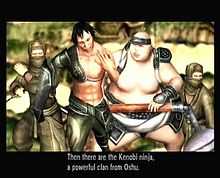
- Kenobi ninja (毛伸衆 Kenobi-shū) – The Kenobi are always alert, moving swiftly and silently, with little talk. Sneak attacks on the ground prove exceptionally difficult against these opponents, and attacks from above and from within close proximity are Goh's best course of action. Kenobi ninja utilise shuriken and status-damaging projectiles such as "Spheres of Weakening" and "Confusion Spheres." Their attacks are similar to Goh's and are of roughly similar speed, making them tough to withstand if confronting more than one opponent. Their dark clothing makes them difficult to spot from afar, and the rain will afford them the same stealthy cover as it does Goh. They are sometimes seen working alongside their leaders, Hebitonbo and Uzumushi.
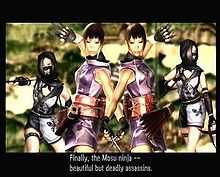
- Mosu ninja (喪巣忍者) – The Mosu kunoichi are very fast and agile. They tend to gather in groups and keep their distance, preferring to attack Goh with kunai rather than allow the player to draw them into mêlée combat. Although they move slowly when patrolling, they have a tendency to stretch and lean against walls to warm up and avoid cramping, straying from predictable patrol patterns. This activity gives them the ability to see behind and above them, making sneak attacks difficult to achieve. Mosu kunoichi have a tendency to constantly talk to themselves, giving away their positions every few moments. The Mosu will sometimes be seen working alongside their leaders, Ageha and Usuba, during missions.
- Yojimbo (用心棒 Yōjinbō) – Former samurai and ronin warriors, these mercenaries work alone and are usually hired as high-level bodyguards and elite soldiers. Yojimbos are easily distinguished by their dark green kimonos and calm demeanor, and they are usually seen leaning against walls or casually strolling. They never speak unless in combat and do not patrol according to a set pattern, making them difficult to locate in advance and difficult to avoid encountering in the course of a mission, with the subsequent combat proving difficult for the player. Yojimbo warriors are highly skilled, often on par with a warlord's very best warriors, his samurai generals, albeit with lower stamina. A yojimbo can quite easily eliminate up to four opposing regular soldiers at once with relative ease, and will be more than a match for Goh in direct conflict, especially if another yojimbo in close proximity hears or witnesses the battle. Yojimbos are extremely confident in their abilities and will never call for reinforcements or sound an alert, wishing to claim Goh's head for themselves. Since Yojimbos do not rely on warlords for provisions, it is not possible for Goh to weaken them through the destruction of supply convoys. Goh may also contract yojimbos to protect his hut from barbarian and ninja attacks.
- Samurai generals – The samurai generals are each warlord's most highly valued retainers. They control and command their respective lords' armies and offer tactical advice during battle. Being veteran samurai warriors, they are all highly skilled in combat, sometimes wielding two katana at once, and are usually capable of defeating up to ten regular soldiers, and even ninja, in battle without assistance. Initially, each faction begins with two generals, although more can be appointed, should Goh assist a particular warlord in gathering enough money and provisions to achieve a military build-up. Goh must protect these officers to maintain the strength of, or eliminate to severely damage, a warlord's military capabilities. Goh may be contracted to protect one such officer from an enemy attack and instead slit his throat during the chaos, if doing so would further his own aims.
Development and legacy
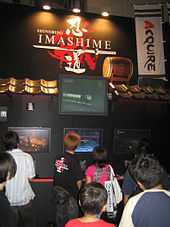
After the Tenchu series was lost to rival Japanese developer From Software, Acquire began development on a new series with similar style and gameplay values in an effort to retain its stealth/ninja genre fan base.
Shinobido Takumi expansion pack
The game's success in Japan spawned an expansion pack which was released exclusively to the Japanese market. The pack, entitled Shinobido Takumi and released in June 2006, contains 130 fan-made missions which have been judged and selected by the Spike development staff to be the best on offer. The creators of the submitted missions chosen by the development team received in-game credit, a copy of the game and an additional commemorative bonus item.[1]
Reception
The game received mixed and mostly average reviews, with an average score of 59 from Metacritic.[2] Critics and reviewers criticised the game's awkward control system,[3] which would at times cause the player to accidentally alert the enemy of his/her presence when attempting a sneak-attack or stealth kill, and also the lack of variety between missions. On the other hand, critics praised the unique story, ragdoll physics and open-ended system which allowed players to choose their allegiance and style of mission,[4] be it stealth or all-out attack.[5] The English language voice acting is described by Boomtown's reviewer as "patchy", adding that "some of it works, most of it doesn’t".[6]
Legacy
Another title in the series, Shinobido: Tales of the Ninja, is available on the PlayStation Portable. Acquire has stated and apologized on its official website that, due to circumstances beyond their control, there was no planned North American release.[7] A sequel to the PlayStation Portable game, titled Shinobido 2: Tales of the Ninja was released for the PlayStation Vita.
References
- ↑ "Shinobido Takumi (PS2)". GameSpy Industries. Retrieved 2007-10-13.
- ↑ "Shinobido: Way of the Ninja (ps2: 2006): Reviews". Metacritic. Retrieved 2007-06-25.
- ↑ Pearson, Dexter. "Reviewed: Shinobido: Way of the Ninja". Ace Gamez. Retrieved 2007-06-25.
- ↑ Kendall, Nigel (2006-08-26). "Shinobido: Ways of the Ninja". Times Online. Retrieved 2007-06-25.
- ↑ Ramsay, Randolph (2006-07-20). "Shinobido: Way of the Ninja Review". CNET. Retrieved 2007-06-25.
- ↑ Brotherson, Corey (2006-09-22). "Shinobido: Way of the Ninja review". Boomtown. Retrieved 2007-06-25.
- ↑ Acquire Corp
External links
- Shinobido: Way of the Ninja official website (English)
- Shinobido: Imashime official website (Japanese) / (English)
- Shinobido: Imashime ACQUIRE site (Japanese)
Shinobido: Takumi
- Shinobido: Takumi official website (Japanese)
- Shinobido: Takumi ACQUIRE site (Japanese)
Shinobido: Homura
- Shinobido: Homura official website (Japanese)
- Shinobido: Homura ACQUIRE site (Japanese)
- ACQUIRE Games (Japanese) / (English)